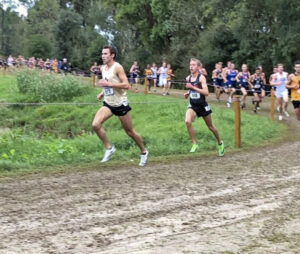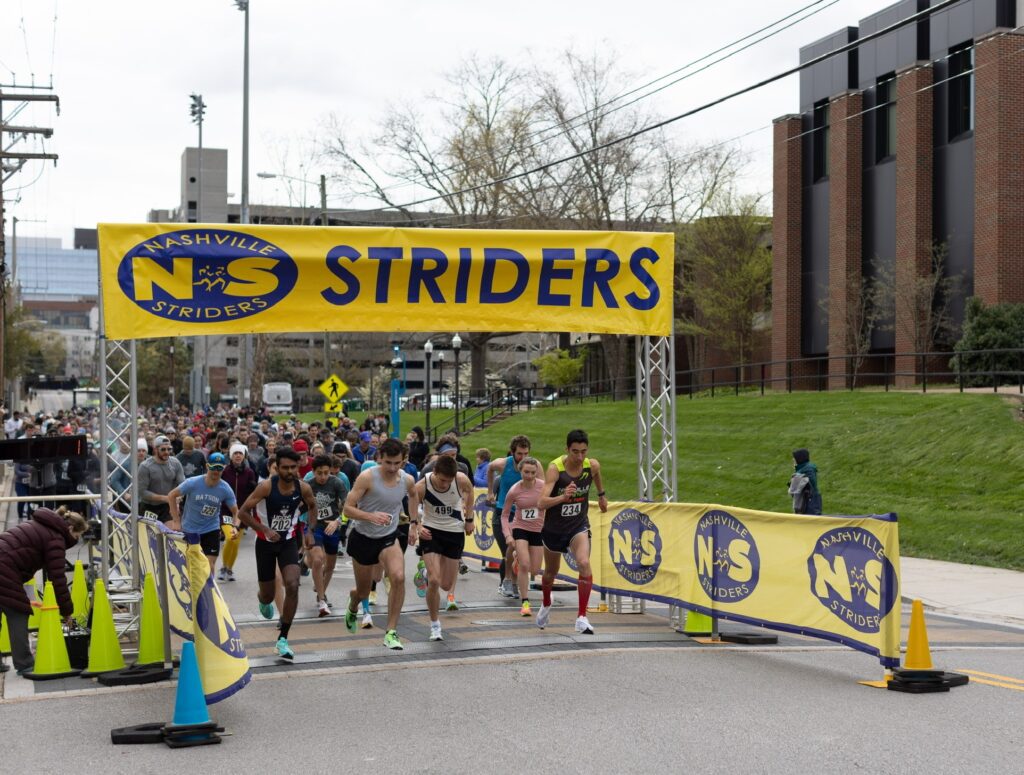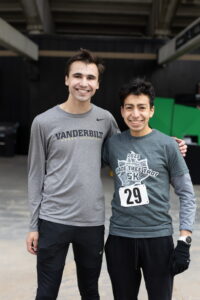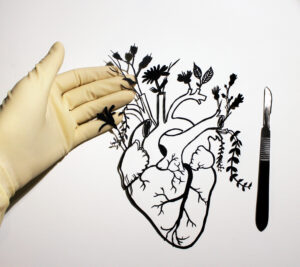Second-year Vanderbilt University School of Medicine medical student Harrison Thomas served as this year’s Shade Tree Trot 5K Run/Walk director, leading an effort to raise $46,500 for the student-run free clinic
By: Lexie Little
Harrison Thomas felt a tug in his right hip as he raced past Southeastern Conference opponents on a cross country course. A collegiate runner at Vanderbilt University, he regularly stretched, warmed up, and stayed fit to avoid cramps and injuries. But after several months trudging through, he knew this increasingly persistent pain warranted a trip to Vanderbilt University Medical Center.
“I had hip issues chronically throughout my undergrad time that would sideline me for brief periods,” Thomas said. “Right when COVID started, I was having bad hip pain on my right hip, and it never got better. I had to take a ton of time off [from running]. All of that happened around the time I prepared to start med school. I had taken months off of running without any improvement. I ended up seeing one of the orthopaedic surgeons here and started physical therapy (PT). PT helped a little bit. I started to try to run again, and it didn’t get any better.”

He continued his undergraduate studies in biomedical engineering while trying to improve his mobility. He also applied to medical school just as a global pandemic gripped the world in 2020. Thinking intensely about medicine, his attention fluctuated between future doctor and future patient, considering his need for further care.
In January 2021, during his first year of medical school at Vanderbilt University School of Medicine, he realized he needed to get an MRI.
“I didn’t want it to get to that point, but it had been nine months without any improvement in the hip pain,” he said. “Nine months is a long time. I got an MRI, and I found out that I had a torn labrum, [the rim of cartilage that lines the hip ball-and-socket joint]. I had arthroscopic hip surgery in March of 2021. I had some bony abnormalities called femoral acetabular impingement syndrome, [where extra bone grows along one or both of the bones that form the hip joint], which explained why I’d had hip issues before. That condition is what caused the tear in the labrum, so my surgeons repaired the labrum and fixed the bone problem in surgery.”
For months, Thomas had attempted to run on a grating tear that would not heal without surgical repair. The pain led him to fear he would never run normally again. But the successful surgery revived his hope of running, and he set goals for one race in particular: Shade Tree Trot 2022.
The start
Shade Tree Trot began in 2009 when then medical student Brian Drolet organized a 5K run/walk to benefit Shade Tree Clinic, Vanderbilt’s student-run free clinic for Nashville’s underserved populations. Drolet, now Chief of Hand and Upper Extremity Surgery at Vanderbilt University Medical Center and Associate Professor of Plastic Surgery at VUSM, started what has since become an annual tradition attracting hundreds of runners and donors.
Thomas volunteered at the race in 2019. As a Vanderbilt undergraduate student, he connected with the medical community through volunteerism at Monroe Carrell Jr. Children’s Hospital at Vanderbilt and through the VU Pre-Med organization.
As Thomas hopped on the therapy bike two days after his operation, he set a goal to run in the next Shade Tree Trot in addition to the annual College Cup 5K, a race for the members of the four MD student colleges at VUSM.
The journey ahead seemed like a long road.
“After surgery, in the process of recovering, I wasn’t allowed to run for 12 weeks,” he said. “That was hard. On post-op day two, they made me bike, which was horrible,” he said, laughing. “I was so swollen. They said it was really important to be mobile as early as possible. At the same time, we were learning the anatomy of the hip. I had hip surgery, and we had our lectures on the anatomy of the hip. I really didn’t miss any school except for the day I had surgery. It was a Friday, and I came back on Monday on crutches. I was on crutches for two weeks. I stood in the anatomy lab on crutches. Bless my anatomy partner, Anne Altman-Merino, for helping me. I was pretty useless, but I was still there.
“In the process of recovering, I went from biking to the elliptical, and after 12 weeks, I was finally cleared to run. Not running for so long and not really having a goal to look forward to in terms of training, the one thing I looked to do was the College Cup 5K. As I was on the bike and the elliptical, getting slowly back into running, that was my goal for racing again. It had been so long since I’d raced, I just wanted to be able to race that 5K even though it wasn’t a huge event [like a marathon]. College Cup is serious, and I wanted to be able to contribute to my college and just to be able to run an okay time for that.”
Thomas finished with the best men’s time at the 2021 College Cup 5K. With that energy, he found strength to push forward in his medical career and in running with the support of his classmates and faculty mentors, including Dr. Brian Drolet.
One day, Thomas walked into the operating room with Drolet, a primary mentor to the aspiring plastic surgeon. As they made small talk before a case, Thomas mentioned the prospect of acting as Shade Tree Trot co-director. Naturally, Drolet enthusiastically encouraged his student.
“Go for it,” Drolet said, gratified. “I actually started Shade Tree Trot with my classmates in 2009. How cool would it be if you were the director and followed after me?”
Thomas, pleasantly surprised and grateful for the encouragement, immediately signed on to co-direct the race with fellow M2 student Steven Bishay.
Drolet appreciates the work each director brings to the fundraising effort.
“Leadership of the Shade Tree Trot is one of more underappreciated activities for Vanderbilt medical students,” Drolet said. “This community event takes a massive effort, which is completely run by medical students like Harrison and Steven every year and is a primary funding source for the Shade Tree Clinic. Harrison is a natural leader. He is thoughtful and kind, which inspires others to want to work with him on aspirational projects like the Shade Tree Trot.”
The race
The night before Shade Tree Trot, Thomas’ thoughts raced. He ran through lists of items he needed to check ahead of the event in the morning: tables, food, water stations, registration, roadblocks. He woke with a start and made his way to Jess Neely Drive where running the Trot himself would be a game-time decision.

“I am strict about how I warm up for races, and that went completely out the window,” he said. “I didn’t get to do any of the things I would have normally done going into a race. I just kind of jogged up to the starting line after having run all over the course to make sure everything was set, and I said, ‘Okay, I’m doing this.’ I had hardly been running – I quit running during my surgery clerkship because I didn’t really have the time, and I didn’t want to because it was cold then…I was happy to be able to run it and experience the first in-person race in three years while ensuring that everyone else got to enjoy it. Being part of the race I helped to put on was a really cool experience.
“I got to see so many people there. My classmates said ‘Woah, this is like a really legit event,’ and I said, ‘Yes, thank you. Thank you.’ That validation for our efforts was great. I volunteered at the 2019 Trot when I was in undergrad, so I remembered the last time the event happened in person – the last time it was a big event. Being on the other side of it as a med student leader was a cool ‘Wow, I’ve come so far in three years’ moment.”
As he passed fellow runners along the course, Thomas connected with scores of former VUSM students and community members. The race winner, Benjamin Li, served as Shade Tree Trot director during his time at Vanderbilt and is now a fourth-year resident in San Francisco. Li traveled back to Nashville to run and support the clinic, something Thomas hopes to do no matter where his future career takes him.

With so many runners returning to Nashville for Shade Tree Trot, co-director Steven Bishay also felt a sense of gratitude for organizers and participants. He and Thomas prepare to co-direct the race again next year, this time with even greater hopes to break records in fundraising and participation.
“Harrison was an amazing co-director to work with,” Bishay said. “He was hard working and was willing to sacrifice time and effort to make this a successful fundraiser. I look forward to working with him next year as well. In terms of Shade Tree Trot itself, I think this year was a great success. The community was ready to support the Trot after these past couple of years being virtual. The volunteers were the real heroes, and we were able to get everything organized and setup for a great race day.”
Thomas appreciated his co-director as an “awesome help” and remains grateful to all the volunteers, sponsors, and the VUMC Development Office that helped them raise more than $46,500 at this year’s Trot. Drolet led in individual fundraising, while the Vanderbilt Plastic Surgery Department led as the top team.
Now that the race is over, Thomas turns his attention to catching his breath in preparation for his long journey toward becoming a plastic surgeon.
Catching his breath
Following his hip surgery, Thomas traced the lines of his scars. His incisions had reopened, and a suture abscess formed, leaving deeper marks than he and his surgeon had hoped (though the operation proved a complete success and alleviated Thomas’ pain, to the point he describes his joint as “perfect”). But he sees the art in what those lines could mean, if not for him, then for future patients.

“I have always been very interested in the creative visual arts, since a very young age. I have been drawing, creating ceramics, printmaking, I’ve worked in almost every medium and am visually minded,” Thomas said. “I like thinking in a 3D space…When I started medical school, I didn’t really understand what plastic surgery was or what plastic surgeons did, but I started to see some of the cases, and I’ve found that it’s like the perfect blend of engineering, and art, and medicine all in one specialty – the way plastic surgeons have to think about the anatomy everywhere and think in very technical, 3D terms, but also being able to appreciate the subtle visual changes and things that need to be tweaked to make sure patients have a good aesthetic outcome. It felt like the perfect fit once I started to see what it was.
“I’m more interested in the reconstructive side of the specialty, so they do a lot of free flaps for people who have had breast cancer, breast reconstruction, or trauma patients who have various defects that will need coverage like complex bone coverage. They can essentially take different parts of the body and reconnect it elsewhere using the knowledge of the anatomy and very delicate technical hand skills that are kind of artistic in a sense.”
Recently, Thomas collaborated with students like recent graduate Colin White-Dzuro, MD (who matched into plastic surgery residency at UT Southwestern) and faculty like Drolet to explore plastic surgery research.

Thomas created anatomical graphics for a case report on chest wall reconstruction, showing different surgical options for various reconstruction pathways. He said the anatomical and surgical visual that combined surgery, art, and plastics in a research space stands as a proud achievement in his young career.
His mentors like Drolet equally take pride in his work, both his artistic talents and his promise as a future academic surgeon.
“Harrison is an amazing artist and his attention to detail is off the charts,” Drolet said. “He also developed an executed a microsurgery training course for residents that can be done remotely.”
In 2021, Thomas and collaborators Drolet, Keith Meador, MD, and the late Kate Payne, JD, published a paper in the Journal of Graduate Medical Education. The study, for which Thomas served as lead author, focused on an interdisciplinary biomedical ethics certificate program for graduate medical education trainees.
As a future physician, Thomas hopes to bring his passions for art, surgery, education, and ethical, informed care to his practice.
Looking toward the finish line
As he continues to work toward the finish line of graduation from medical school in 2024, Thomas reflects on his start as a foundational approach to research, rotations, and patient care.
His own experience as a patient informs his approach to patients. After his surgery, Thomas scheduled physical therapy around classes and doctor’s appointments, learning firsthand how to navigate a complex care system. Having not experienced surgery in a clinical learning setting at that point, he asked many questions about his medications and wound care measures. He quickly learned the importance of counseling patients on what each medication and care measure means for recovery, including signs for complications like those he experienced.
Beyond his experience as a patient, he also informs his learning and care through experiences as a volunteer at the Children’s Hospital.
“I think [volunteering at the Children’s Hospital] played a really important role in just seeing how patients interact when they’re not with doctors,” he said. “That was kind of the whole point of being a volunteer, being outside of the scope of why they’re in the hospital and trying to normalize kids playing. It was a fun time to help kids be kids, not so focused on their time in the hospital. I think now that I’m in med school, I see the importance of that – how hard it is for families. When I was on my pediatrics rotation, I rotated with hematology and oncology and got to see child life come in and be the fun ones. We, the medical team, were not the fun ones. I think it showed me the importance of being able to provide some normalcy as a provider in any way you can like consulting child life, which they almost always do, or bringing fun toys, or making the environment a little bit lighter when you’re dealing with hard conversations.”
Beyond patient care, Thomas’ days as a pre-med volunteer also remind him to give back to the next generation of medical students through advice, encouragement, and visibility. During his days walking with pediatric patients toward the hospital playroom, Thomas encountered medical students on their clerkship rotations.
Their presence alone reminded him of possibilities for his future.
“I distinctly remember seeing med students in the Children’s Hospital,” he said. “I thought, ‘Woah, these are med students. I hope to be them one day.’ I knew [M4] Carsen Cash when I was in high school. We went to neighboring schools. I remember seeing him when he was on his pediatrics rotation…I remember that being such a fun, small world kind of moment. I also remember seeing [M4 and future pediatrics resident] Caroline Maguire. I remember meeting her in the elevator and saying, ‘Oh, I’m applying to med school right now.’ I think it was right around the time I got my interview at Vandy. And she said, ‘I love Vandy Med so much.’ She was just so excited, and her excitement about the school and about the people made me think, ‘Woah, the School of Medicine must be really awesome.’”
Thomas, the first person in his family to attend medical school, sought mentorship as an undergraduate student. He connected with Kyle Langford (MD ’21), who also attended Vanderbilt for both his bachelor’s degree in biomedical engineering and his MD.
Langford discussed the process of applying to medical school, gave advice for interviews, and offered perspective on how Vanderbilt stood out from other programs.
“[Langford] was really helpful in navigating the process of applying because it is unique and specific in the things you must do and all of the essays,” Thomas said. “He helped me learn how to navigate interviews as someone who doesn’t have any doctors in the family. I didn’t know anyone who had done this before. Navigating that process blindly is really hard, so to have someone walk me through each step of that process – and the unspoken dos and don’ts – I don’t think I’d be here without that mentorship.”
Now, Thomas mentors pre-med students, following in the footsteps of those who helped him along the way. He admits he still has a lot to learn, especially as he plans his schedule for the upcoming year.
As a rising third-year medical student, Thomas will immerse himself in unique rotations and research. MD students in Years 3 and 4 craft their schedules with individualized elective clinical experiences, research time, integrated science courses, and acting internships to explore areas most relevant to intended specialties and career interests. Thomas hopes to dedicate this fall to his research project, taking rigorous courses in the winter months before a month off in April 2023.
“I’m looking forward to shifting gears,” he said. “I get to choose when I want things to be more calm or more busy. I built my schedule so I can direct Shade Tree Trot again next year, I’m taking a vacation month in April. Trying to plan the run/walk during medicine and surgery clerkships was hard. I’m planning a calm fall because I’m training to run a marathon in October, and I’m hoping to qualify for the Boston Marathon in April 2023. That would be another reason to take April off.
“It’s really nice to be able to choose when you want to be busy and when you want to have some freedom after being so busy for two years. Having the accelerated curriculum is nice because you learn so much so fast. Now, I think, ‘Wow, how did I learn so much in the past two years?’ It’s kind of crazy. To think in another year, I’ll look back and ask how I’ve continued to learn so much…That’s the benefit of this curriculum.”
In a last-minute decision, much like the morning of the Shade Tree Trot, Thomas ran a marathon on May 7.
He earned his qualifying time for the Boston Marathon.